Rapid building assessment placarding system
Last updated: 30 October 2023
The rapid building assessment system includes 'placarding' buildings.
Placards indicate whether or how a building may be used. There are three placard colours. When a Rapid Building Assessor makes a judgement on the usability of a building, they are required to outline this on the placard they choose to use.
Placards are sometimes referred to as stickers, signs or notices. MBIE uses the term placards.
The different coloured placards let you know what the next step is.
Changes to the rapid building assessment placards
MBIE has revised the rapid building assessment forms and placards. The revisions have simplified the placards where practicable to provide ease of use for territorial authorities, Rapid Building Assessors and to simplify information for building owners and occupiers. All changes were made in line with the provisions of the Building Act.
The new placards were approved by the General Manager of Building System Performance (under his delegated authority from the Chief Executive of MBIE) on 1 November 2023, and can be used in advance of that date. Any placard posted under section 133BT of the Building Act 2004 must be in the approved format.
MBIE has produced a quick guide detailing the changes to the placards and rapid building assessment forms, including implementation information for territorial authorities.
Building Emergency Management – Guidance for Territorial Authorities – quick guide [PDF 1.2MB]
Red placard
A red placard means entry is prohibited. Your building may pose a significant risk to public safety, health, and wellbeing. The risk could be from the building itself, from adjacent buildings or from land instability.
It does not necessarily mean the building will need to be demolished.
There are two classifications with a red placard:
- R1 specifies that the building structure has been visually inspected and found to be seriously damaged and/or unsafe to occupy.
- R2 specifies that the building is at risk of being affected by an external hazard and the building is unsafe to occupy.
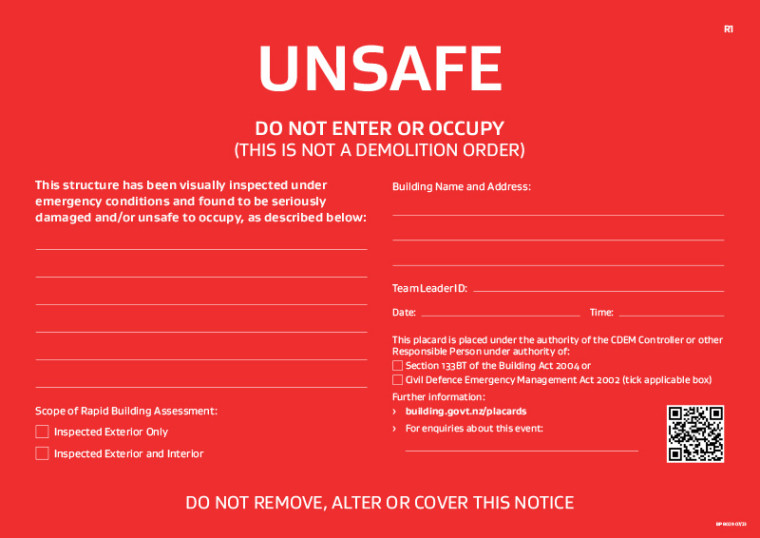
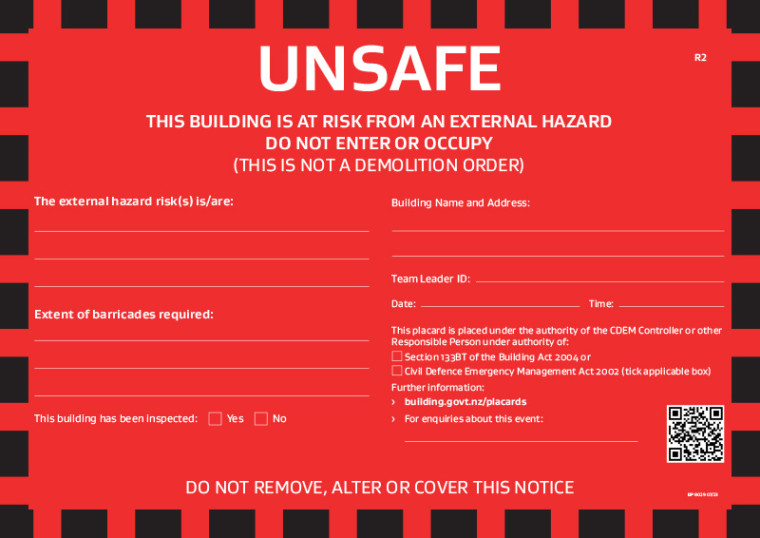
View the R1 & R2 red placards [PDF 44KB]
Yellow placard
A yellow placard means that access to your building is restricted and cannot be used or that you cannot enter except under supervision for a limited time or on essential business. Part or all the building may have sustained moderate damage, or some areas of the building, neighbouring buildings, or land instability pose a significant risk.
There are two classifications with a yellow placard.
- The Y1 placard specifies restricted access to parts of the building only. This means that parts of the building have sustained damage or are at risk from external hazards.
- The Y2 placard specifies that access to the building is allowed on a short-term basis only, with supervision.
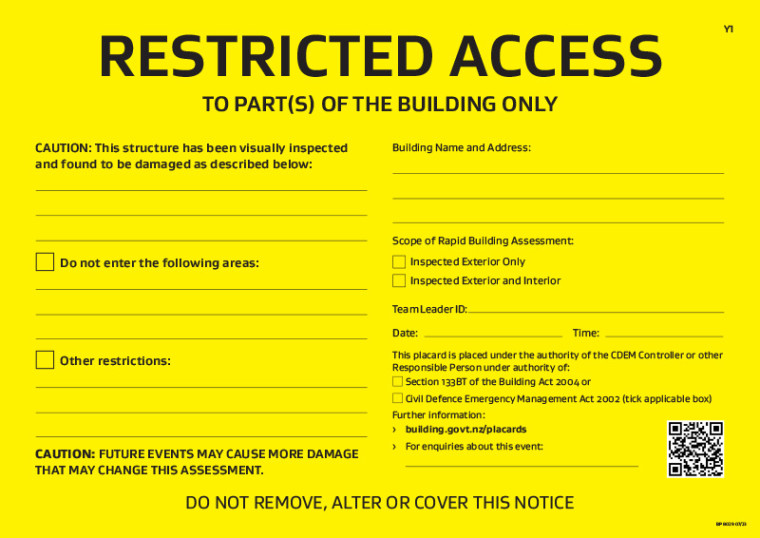
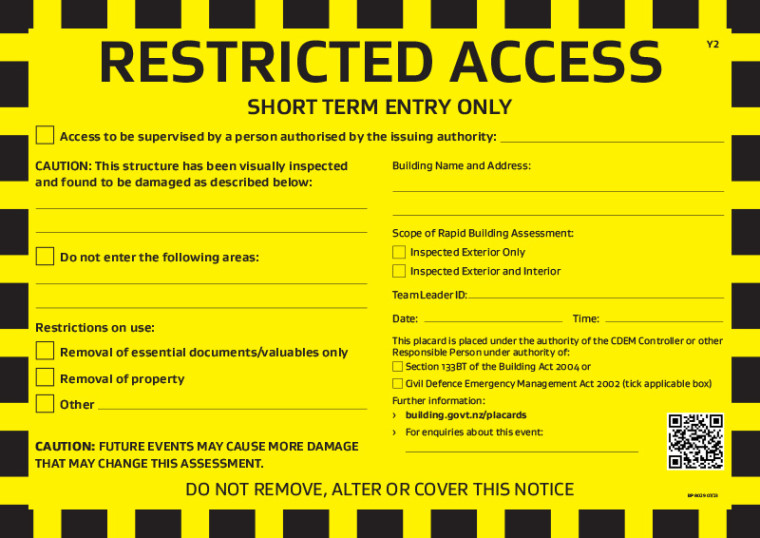
View the Y1 & Y2 yellow placards [PDF 48KB]
White placard
A white placard means that your building can be occupied. It does not mean that the building is not damaged. Be on the lookout for damage and contact your landlord or rental manager if you rent your home.
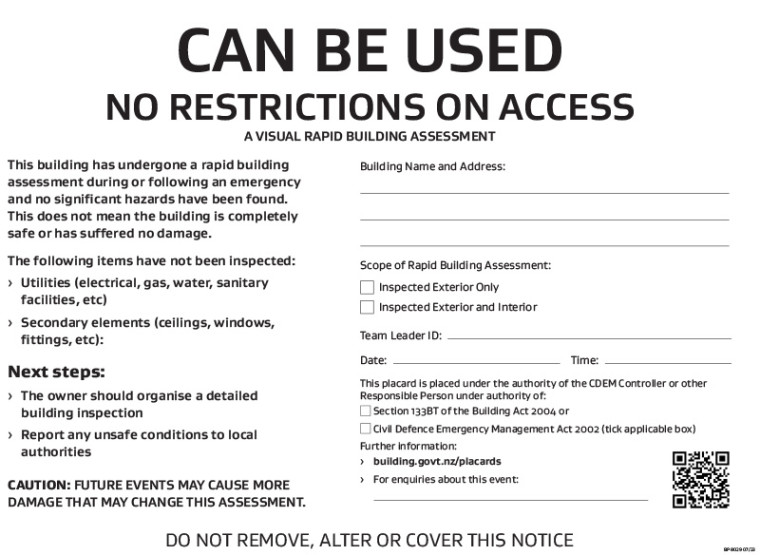
View the white placard [PDF 43KB]
More information about the different placards
If your home or building is undamaged, but at risk of being damaged by another home or structure nearby, it will be assessed based on that risk.
It is important that you must not enter your home if it has been issued a red or yellow placard. You must also not remove, alter, or cover a placard once it has been issued. Interfering with a placard is an offence under the Building Act and penalties may apply.
Authorised officials may also put in place measures considered necessary to keep people at a safe distance or to protect homes and buildings. These might include cordons, barricades, and other measures to prevent or limit public access, or prevent the building or debris from harming people. It is important that you do not bypass or interfere with any such measures.
Offences and penalties
The Building Act sets out several offences and penalties for non-compliance of instructions in an area which has been designated.
All Building Act offences and penalties relating to these provisions are in sections 133BR to 133BU, and 133BW and 133BX of the Building Act. For example: it is an offence to intentionally occupy or use a building other than in accordance with a sign or notice placed under section 133BT of the Building Act 2004 or permit another person to do so. It is also an offence to damage, alter, remove, or interfere with a placard.
The penalties include the ability for fines to be imposed following conviction if a person intentionally fails to comply with the relevant provisions of the Building Act.
The responsible person will consider the appropriate compliance approach. Generally, the building control manager within the territorial authority would recommend to the responsible person the compliance approach to be taken.
Removing or changing a placard
To get a placard changed or removed, building owners should in the first instance contact their local council/territorial authority as well as their insurer. You cannot remove or change a placard yourself. Tenants should contact their landlord for more information.
The territorial authority should be able to tell the owner what steps will need to be taken to have a placard changed or removed, while the owner's insurer will be able to provide information regarding what professionals and inspections will need to be organised (eg geotechnical or structural engineers, licensed building practitioners).
A territorial authority may need evidence about the structural status of the building after any repair work recommended by the building owner's insurer.
If a designation under the Building Act is in place, the ‘responsible person’ (who in most cases is the territorial authority) has the power to proactively direct a building owner to provide this evidence if needed to determine the risks posed by the building or whether to exercise any further building emergency management powers.
Once an owner has the required evidence, they should contact the territorial authority, who will reassess the placard status. In instances where there is widespread damage, a reassessment of a placard may take some time, although territorial authorities should prioritise the reassessment of red placards.
Changing/removing a red placard
When repairing a building issued with a red placard, it is important that any work is done in liaison with the building owner's insurer, the local territorial authority and in conjunction with appropriate experts and professionals.
No one should enter the building unless authorised to do so. To begin the process of repair/remediation, an owner should first contact their insurer, who should arrange (or help to arrange) for more detailed engineering evaluations.
A building owner will also need to work with their local territorial authority to arrange authorised access for an appropriate professional so they can assess the damage (eg geotechnical or structural engineer, builder, drainlayer or plumber).
The territorial authority will, if appropriate, issue authorisation to access the building. In some cases, access may be refused, for instance due to a high risk to life safety.
Repair and remediation work
In the case of a red placard, it is likely that a detailed evaluation will need to be undertaken, usually by a structural or geotechnical engineer, who can provide advice on building usability and options to address any damage, eg repair or demolition.
A detailed evaluation should also describe what remedial actions are possible to be completed to recommend a change in placard status, including:
- whether the building owner needs to apply for building/resource consent, or a discretionary exemption from the requirement for building consent for remedial works required to request a placard change; or
- whether to carry out other remedial works, for which consent is not required, that are required to request a placard change.
Owners may need to carry out urgent repairs during an emergency period when it is not possible to process building consent applications. These repairs often involve building work that in normal times would require a building consent. If there is urgent work that needs to be done, the homeowner should contact their insurer and territorial authority before proceeding.
Changing/removing a yellow placard
The process for getting a yellow placard removed is essentially the same as for a red placard. The building owner should work with their insurer and their local territorial authority to determine the repair work that is needed for the building to make it safe for occupancy, and to authorise access where it is restricted. A detailed evaluation may be required or recommended by the owner’s insurer.
Changing/removing a white placard
Building owners need to leave white placards up until they are authorised to remove it, for example, the territorial authority advises it can be removed, or if the placard has been issued with an expiry date and that date has passed.
Reassessment of placards following works
Once any appropriate work has been undertaken, a building owner needs to contact their territorial authority to have their placard status reassessed. This is to determine if the risks have been sufficiently reduced for the placard colour to be changed.
A territorial authority may request evidence from a geotechnical or structural engineer before reassessing the placard. A reassessment of a property subject to a placard will examine the building post-repair against the risks noted in the original placard decision. It may be that a red placard is downgraded to a yellow, or a red placard removed altogether if the risks have been sufficiently reduced to a point where the building can be occupied.
A home or building owner does not need to progress down the placard system from red, yellow to white. A placard colour is a reflection of the present risk.